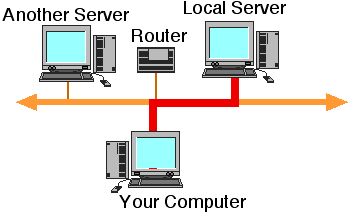

There are two approaches to doing this fragmentation:
The simplest approach from the end-system point of view is not to worry about the MTU size. In this simple approach, the sender simply has to ensure that each packet is less than the MTU of the link on which it is sent. (The router always knows this from the link interface configuration information).
 Large IP packets that exceed the MTU of the link between R1 and R2 are fragmented by R1 in to two or more IP packets each smaller than the MTU size.
Large IP packets that exceed the MTU of the link between R1 and R2 are fragmented by R1 in to two or more IP packets each smaller than the MTU size.
The network layer then has to arrange to cut packets up into smaller fragments whenever a router encounters a link with an MTU smaller than the received IP packet size. All the fragments of an IP packet carry the same ID in the IP packet header (allowing the final receiver to reassemble the fragmented parts into the original PDU). This is called "IP fragmentation" or "IP segmentation". The problem is, this offloads a lot of work on to routers, and in the worst case, can also result in packets being segmented by several IP routers one after another, resulting in very peculiar fragmentation.
To fragment/segment a long internet packet, a router (R1 in the figure below) creates a new IP packet and copies the contents of the IP header fields from the long packet into the new IP header. The data of the long packet is then divided into two portions on a 8 byte (64 bit) boundary, so that the first packet is less than the MTU of the out-going interface. The more-fragments flag (MF) in the first packet is set to one (to indicate that more fragments of this packet follow). The More Flag may already be set in this packet if it has already been fragmented by another system. This packet is forwarded.
The second created new packet is then processed. The packet header field is identical to that of the original packet (including the same value of the packet ID, the total length field, the more-fragments flag (MF) and the fragment offset field in the original packet). The packet header field is updated with a new offset field, by adding the number of payload bytes sent in the first fragment. If this new packet is larger than the allowed link MTU, the packet is again fragmented.
Any packet that has a more fragments (MF) flag set, must have an integral multiple of 8 bytes. (The final fragment, which does not have this flag set, may have an arbitrary number of bytes).
IP Router fragmentation is not recommended in the modern Internet, and this feature was not carried-forward when the next generation Internet Protocol (IPv6) was specified.
Path MTU Discovery allows a sender to fragment/segment a long internet packet, rather than relying on routers to perform IP-level fragmentation. This is more efficient and more scalable. It is therefore the recommended method in the current Internet. This is also the only method supported in IPv6.
IP fragmentation and reassembly employs updating and using the values in the second 32 bits of the IPv4 packet header. An end system that accepts an IP packet (with a destination IP address that matches its own IP source address) will also reassemble any fragmented IP packets before these are passed to the next higher protocol layer.
The system stores all received fragments (i.e., IP packets with a more-fragments flag (MF) set to one, or where the fragment offset is non-zero), in one of a number of buffers (memory space). Packets with the same 16-bit Identification value are stored in the same buffer, at the offset specified by the fragment offset field specified in the packet header.
Packets which are incomplete remain stored in the buffer until either all fragments are received, OR a timer expires, indicating that the receiver does not expect to receive any more fragments. Completed packets are forwarded to the next higher protocol layer.
See also: